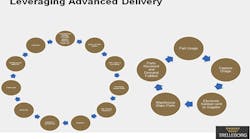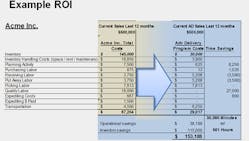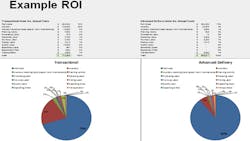ACME Co., a cylinder maker, reports sales of about a half million dollars over 12 months. It maintained an inventory worth $145,000. It looked at itself in the mirror and decided it was bloated. So it implemented a delivery program with its suppliers, reducing inventory to $30,000. Besides inventory savings, it realized additional savings with more efficient operational procedures and better use of labor. Besides the $115,000 in inventory costs, it saved $38,188 in operational procedures, totaling $153,000 or 501 hours saved.
A real OEM could simulate the success of this fictitious company by working with its procurement or buying department to make better use of its entire supply chain. Let’s look at seven ways manufacturers can partner with service providers to reduce their inventory and streamline logistics and market planning via advanced delivery.
1. Prioritize the management of A-, B- and C-class items. Inventory classification is typically based on price for A-, B- & C-class items and manufacturers can benefit from delivery programs that shift focus from C-class items representing a low value spend in terms of overall inventory purchases but often a high level of associated non-value processes. These programs create a shift in resources so the focus can be on more effective management of high value A & B-class items.
2. Track Usage of parts.
By tracking parts usage, inventory and operating costs can be reduced, cycle times shortened and parts made more available.
3. Work with an advanced delivery program to make better use of assets.
Typically resources can be optimized by focusing on:
- reducing time spent in purchasing and planning activities
- cutting the number of operations
- lowering the number of times parts are handled
- improving part availability
- implementing visual signals to ensure the necessary size and number of parts are available when they are needed.
This kind of focus can help consolidate vendors and reduce the stress of expediting inventory in a rush.
4. Improve Management of C-class items
Advanced delivery programs can include forward stocking location, delegated inspection authority/dock-to-stock, Kanban/direct line feed, vendor managed inventory, (pull system bin stocking) and vendor consolidation/C-class management. A centralized purchasing resource can consolidate vendors and reduce purchase orders. These suppliers should be able to manage inventory using forecasts while also providing value-added handling and packaging services like single/bulk bag and tag, kitting, assembly, special marking and surface treatment.
5. Deliver forecasts to suppliers for the best possible outcome.
A manufacturer should expect a supplier to meet and discuss their supply chain operations. All the areas where value can be contributed should be assessed and a delivery plan customized accordingly. The starting point for this would usually be the manufacturer’s forecast. The planning system should manage the flow of parts and establish the appropriate size of inventory.
6. Consider special handling and packaging.
This incorporates a wide range of services including custom labeling, barcoding, cluster packaging, kitting and assembly, direct bag printing and mil spec packaging as well as surface treatment marking, assembly of multiple components and kit creation. Additionally, a manufacturer’s branded packaging could be used to allow delivery directly to the end-user.
It can also extend to inbound product inspection, corrective and preventive action, production part approvals, quality inspections and technical support, process improvement recommendations, internal and external auditing, validation testing and custom certification packets.
7. Analyze your Kanban system.
The two-bin Kanban system is simple. As the first bin empties, a scanner captures the information and once the bin is emptied, the system tracks the use of those parts and that data from the field scan is uploaded to a logistics center.
The logistics center receives the information and automatically sends a replenishment pack to replace the used contents from the designated bin. The parts within the second bin are accessed while awaiting replenishment from the first bin. As usage increases, the replenishment cycle quickens and as usage decreases, the replenishment cycle lessens.
Will Bacon is advanced delivery program manager at Trelleborg Sealing Solutions.






